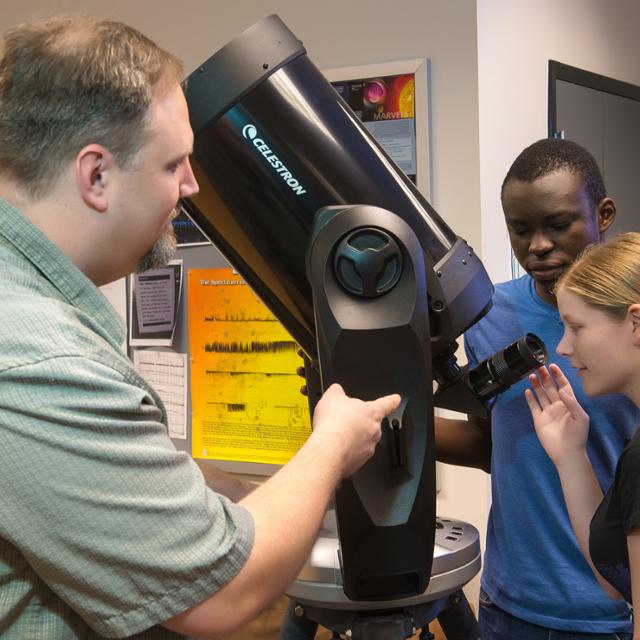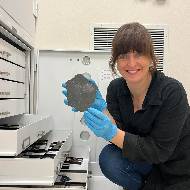Astrophysics

The TCU Galaxy Evolution Lab is a partnership within the Department of Physics and
Astronomy joining the research groups of Dr. Kat Barger, Dr. Michelle Berg, Dr. Rhiannon
Mayne, and Dr. Peter Frinchaboy to study all aspects of galaxy evolution for nearby galaxies, including the Milky
Way and its satellite galaxies. This group seeks to understand the major components
of galaxies, stars, gas, and dark matter.
In addition to the research being done within the TCU Galaxy Evolution lab, we also
hold weekly group meetings, a journal club, and additional professional development
and career discussions.
My primary research utilizes multi-wavelength observations (X-ray through mid-infrared) in the investigation of local stellar populations. Of particular interest is the use of star clusters and giant stars to probe the structure and evolution, chemical and dynamical, of the Milky Way and other Local Group galaxies. Related issues such as the role of environment and dark matter content of Milky Way satellite galaxies are also currently under study.
Chemodynamical Evolution of the Milky Way (SDSS/APOGEE & OCCAM surveys)
Understanding the structure of a galaxy from only one point of view is challenging, however being inside that galaxy makes it much more difficult. We understand more about other galaxies structure than we do for our own Milky Way. We are using Galactic star clusters as dynamical probes to determine the structure and evolution of the Milky Way, using the Sloan Digital Sky Survey, the ESA Gaia mission, the Spitzer Space Telescope, and the Two Micron All-Sky Survey (2MASS) to explore the Galaxy as never before. TCU is also an Associate Member in the Sloan Digital Sky Survey (www.sdss.org; SDSS-IV & V) projects that provides faculty and students access to proprietary world class datasets. I am also a leader of the Sloan Digital Sky Survey IV-V and the SDSS survey the Apache Point Observatory Galactic Evolution Experiment (APOGEE). SDSS/APOGEE will survey over 500,000 stars in the galaxy to measure kinematics and provide detailed chemical analysis of 20+ elements in these stars. Many of these stars will be in star clusters. I lead the Open Cluster Chemical Abundances and Mapping (OCCAM) survey exploring age-dated tracers with good distances and chemistry suitable for investigating the chemical evolution of the Galactic disk.
The Binary INformation from Open Clusters using SEDS (BINOCS) Project
Current cluster binary studies are carried out using one of two methods, two-band photometry, and time-baseline radial velocity studies, each of which experience issues which limit their effectiveness in answering the above science questions. However, to deeply understand the binary populations of open clusters, we have created a new method which can determine accurate masses for all members of a cluster within a reasonable amount of telescope time. This new binary detection method is nicknamed BINOCS: Binary INformation from Open Clusters using SEDs. By imaging a star using multiple filters across the spectrum (e.g., UBV RIJHKS[3.6][4.5][5.8][8.0]), one should be able to “re- build” spectral energy distribution (SED) of a star given its parameters: age, metallicity, mass. Similarly, a binary system could not be accurately modelled by a single SED curve, but instead by two SEDs added together. By matching stars to these models, mass can be determined, similar to how temperature could be determined in the idealized black- body case. Since the star is a member of a cluster with known parameters, so age and metallicity are given. By matching stars to models of a library of synthetic single stars SEDs, mass can be determined.
Dark Matter and Local Group Galaxies
Cosmological Cold Dark Matter (CDM) models predict that a galaxy like the Milky Way should have 100’s of satellite galaxies filled with dark matter. The reality is that the Milky Way has tens of satellites and how much dark matter they have is not well determined. A major complication in measuring this is that many of these galaxies are also being torn apart by the Milky Way. The dynamics of dwarf galaxies and stellar streams is the key to understand the evolution of dark matter on small scales. I have worked on exploring the Milky Way dwarf satellites, including Sagittarius, the Magellanic Clouds, GASS, Carina, Leo I and II, Ursa Minor, and Sculptor, as well as, investigating star clusters associated with the Galactic Anticenter Stellar Structure “GASS”, also known as the “Ring”, that may be associated with the proposed “Argo” or “Canis Major” dwarf galaxy. Much of this work is done in collaboration with research groups at the University of Virginia and the University of Utah.
Magellanic Clouds: Case study of inflows, outflows, and tidal bridges
Galaxy interactions displace the gas of the interacting galaxies. These interactions
often lead to the formation of bridges, tails, and streams and also lead to the triggering
of star formation across the individual systems. I exploit the gas surrounding the
nearby Magellanic System to understand how galaxy interactions alter galaxy evolution
and to understand the mechanics of gaseous inflows and outflows.
High Velocity Clouds
Galaxies evolve though a combination of internal and external process. Internally,
galaxies are producing stars. As these stars evolve and as they die, they expel matter
back into their surroundings, but not nearly enough to maintain star formation over
long periods of time. Take the Milky Way for example, the Milky Way will run out of
gas reservoirs in roughly 1 to 2 billion years (Larson et al. 1980). Since the the
Milky Way has been forming stars for much longer than this and because the Milky Way
will likely continue to form stars for quite a while, the Galaxy must be acquiring
gas from an external source.
Surrounding the Milky Way are clouds of fast-moving hydrogen, with velocities inconsistent
with galactic rotation, cover 40% of the sky in neutral hydrogen (e.g., Wakker & van
Woerden 1991; Lockman et al. 2002). The gas around galaxies gas acts as a reservoir
to replenish the gas in galaxies (e.g., Lehner & Howk 2011). The Milky Way acquires
20 to 40% of the Sun’s mass in neutral mass each year from these high velocity clouds
(Wakker et al. 2008).
Fraction of Ionizing Radiation Escaping from Galaxies
At the epic of reionization, the gas around galaxies became ionized. When this happened,
gas had a harder time flowing into galaxies, causing the build up of galaxies to slow.
This phenomena might have also quenched galaxy formation at the smallest scales as
gas had a harder time coalescing.
The ionizing radiation from galaxies might be the dominant source of the reionization
of the universe (e.g., Madau et al. 1999; Bolton et al. 2005). However, high-mass
galaxies alone are unable to reionize the universe (Fernandez & Shull 2011), while
the contribution from low-mass galaxies is uncertain. The amount of ionizing radiation
emitted by galaxies at both the present epoch and the epoch of reionization is poorly
constrained.

My research explores the processes that occurred during the early history of our Solar System, with a primary focus on understanding the formation of differentiated bodies (those with a core, mantle, crust structure). My students and I primarily study the mineralogy, geochemistry, and spectra of asteroidal meteorites to gather information about planetary formation and Solar System evolution.